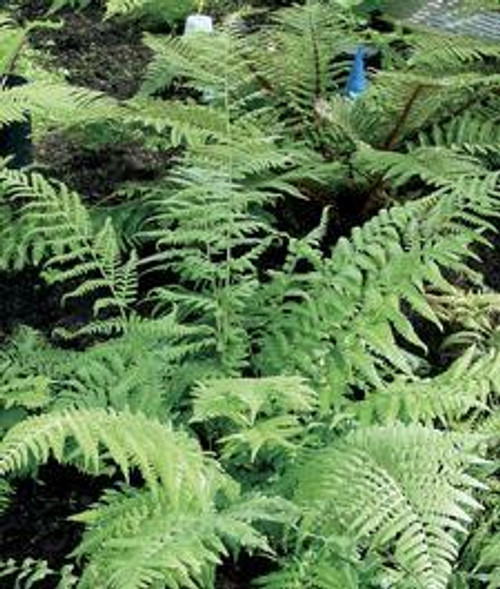Product Description
Thelypteris kunthii 'Southern Shield Fern' (4) 1-gallons
Common names: Shield Fern, Southern Wood Fern.
Zones 7 to 10, Part shade to full shade. Semi-evergreen.
Mature height is 24 to 40 inches tall, upright growth habit,
spreads or creeps quickly to form colonies, rather than clumps. This popular fern is tall and erect with long arching, triangular, glossy, bright green fronds, very hairy on upper and lower surface. Native to southeastern North America swampy woods, when planted in the right location, Southern Shield tolerates heat, drought and some sun.
This hardy semi-evergreen fern is easy to grow in organically rich, medium to wet, well-drained soils. If the frond edges become scorched or crispy, the soil may be too dry. Add 2 to 3 inches of compost or peat moss to the beds each spring or fall. Best frond color occurs in light shade. Use in big containers, as a ground cover or for borders in woodland (in time, it will naturalize into large masses), shady locations, and give it some room to spread.
Thelypteris kunthii, commonly known as the Southern Shield Fern, is a graceful and adaptable fern that thrives in shady, moist environments. It is a fantastic choice for adding lush greenery and texture to woodland gardens, shaded borders, and even indoor spaces. Here is a closer look at what makes it special:
Appearance:
- Fronds: The Southern Shield Fern features long, arching fronds that can reach 2 to 4 feet in length. The fronds are a vibrant light to medium green color and have a delicate, lacy texture. They emerge from a central rootstock and create a graceful, cascading effect.
- Spores: Instead of producing flowers, this fern reproduces through spores that develop on the undersides of the fronds.
Growing Conditions:
- Light: Thrives in partial shade to full shade. It can tolerate some sun, but it is best to protect it from the harsh afternoon sun, especially in warmer climates.
- Soil: Prefers moist, well-drained soil that is rich in organic matter. It can tolerate some dryness, but consistent moisture will help it look its best.
- Hardiness Zones: Hardy in USDA zones 5-10, making it suitable for a wide range of climates.
Uses:
- Woodland Gardens: Its natural habitat is in moist woodlands, so it is a perfect addition to woodland gardens or shaded areas under trees.
- Borders and Edging: The Southern Shield Fern can also be used to create lush borders or to edge walkways and garden beds.
- Groundcover: It can be used as a groundcover in shady areas, forming a dense mat that helps to suppress weeds.
- Containers: It is also well-suited for containers, adding a touch of greenery to patios, balconies, or indoor spaces.
Additional Benefits:
- Deer Resistant: The foliage is generally unappealing to deer.
- Low Maintenance: It is a relatively low-maintenance plant that does not require much care once established.
- Air Purifier: Like other ferns, it can help to purify the air by removing toxins.
Things to Consider:
- Spreading Habit: The Southern Shield Fern spreads by rhizomes, so it can form colonies over time. While it is not considered overly aggressive, it is important to monitor its growth and control its spread if necessary.
- Winter Appearance: In colder climates, the fronds may die back in winter, but the plant will re-emerge in spring.
Overall, Thelypteris kunthii (Southern Shield Fern) is a beautiful and versatile fern that is perfect for adding a touch of lush greenery to any shady space. Its graceful fronds, adaptability, and ease of care make it a popular choice for gardeners of all levels.
(4) 1-gallon containers ready to plant, plants may be trimmed for shipping,
Other Details
The most important part of the plant is its root system. Healthy roots are the foundation of a healthy, vibrant plant. The type of plug container used is based on the specific needs of the plants. Perennials offered as bare root traditionally perform better when planted as bare root.Planted in a specialized mix, potted plants have well established root systems. Top growth stage will vary depending on the current life cycle and time of year when shipped. In Winter and early Spring dormant plants may be shipped. Dormant plants may be planted right away, even before the last frost date.
Most bare root varieties are field grown for at least one season, though Hemerocallis and Hosta are grown for two seasons. The bulk of the soil is removed during the harvesting process and the tops of most varieties are trimmed back to the crown. They are graded, packed in shredded aspen or sphagnum moss and stored in freezers until ready to be shipped.
See our Container Sizes and Bare Root Perennials pages for more information.
Plant information and care is provided in the Overview section, Plant Genus Page and general information is provided in the Planting Care & Guides. Additional questions can be asked on each Plant page.
Plant Spacing: Using the maximum mature spread or width of a plant to guide spacing, ensures space to grow to full size. To fill an area sooner, plant them closer together. Just remember, future thinning or transplanting may be needed.
Water: Keep a close eye on newly planted perennials, especially throughout the first growing year. Most early plant loss is due to too much or too little water!







